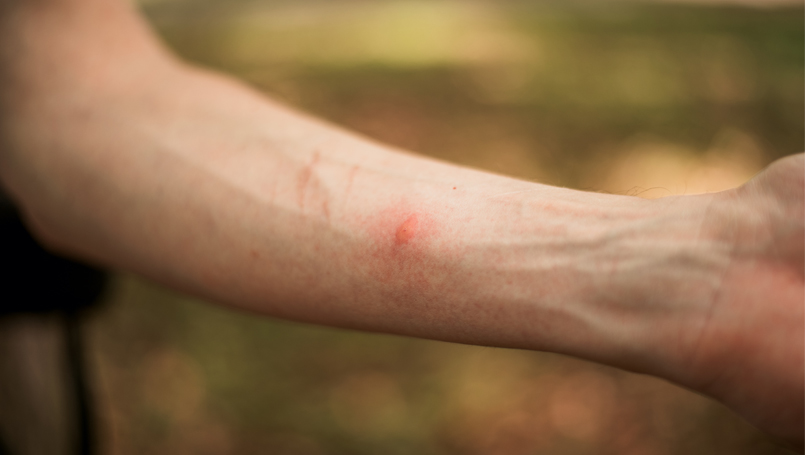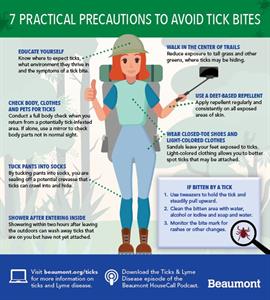
Bugs come out in summertime, and from burrowing ticks to bee stings, they can mean problems for some people. Even the common mosquito bite can cause allergic-type reactions in some children, with red raised skin and other symptoms.
“They can be alarming, especially if you have a child who has a bite above their eyebrow, and it looks like they’ve been punched in the eye; it’s swollen shut,” says Darrell Vlachos, D.O., Beaumont emergency physician.
Here are some tips about common bug bites in Michigan and when they require medical attention.
MOSQUITOS
Mosquito bites are itchy bumps that result after mosquitos puncture your skin to feed on your blood. In children, it’s not uncommon for them to cause large areas of swelling and redness. In rare cases, mosquitos can carry viruses or illnesses, such as the West Nile virus.
How to prevent them
Minimize exposure by avoiding being outside between dusk and dawn, using insect repellent, covering exposed skin or burning citronella candles when outdoors. Also, get rid of any standing water in your yard to eliminate breeding areas.
When to see a doctor
Most local reactions to mosquito bites don’t require any medical attention. However, constant itching and scratching can cause a secondary skin infection to develop. Symptoms may include persistent and even spreading redness, warmth, the development of abscess and possibly fever. If any of this happens, you should seek medical care.
TICKS
Another insect to worry about is ticks, which like to burrow themselves under the skin and can cause reactions such as tick paralysis in some people — or the dreaded Lyme disease, which is spread by infected blacklegged ticks (also called deer ticks).
 If you’ve been traipsing through an area with long grasses or thick undergrowth, carefully inspect your body for ticks embedding themselves into your skin while changing or before taking a shower. It takes at least a day before infected ticks can transmit the bacteria responsible for Lyme disease to their human host, so it’s important to find them early. The disease usually manifests itself via a rash that looks like a bulls-eye.
If you’ve been traipsing through an area with long grasses or thick undergrowth, carefully inspect your body for ticks embedding themselves into your skin while changing or before taking a shower. It takes at least a day before infected ticks can transmit the bacteria responsible for Lyme disease to their human host, so it’s important to find them early. The disease usually manifests itself via a rash that looks like a bulls-eye.
How to prevent them
The Centers for Disease Control and Prevention recommends using insect repellants containing DEET or other chemicals, and avoiding tick-prone areas.
How to treat it
If you find one, use tweezers to carefully remove it, taking care to avoid crushing its body, then cleanse the wound area with rubbing alcohol or soap and water. Save the tick in a plastic bag or container so it can be tested for disease, if necessary.
When to see a doctor
If you don’t have any tweezers, or cannot reach the tick, go to the nearest health care facility where medical staff can remove it. If you develop flu-like illness, sensitivity to light and or rash after noting a tick bite, you should also seek medical attention, Dr. Vlachos says.
INSECT STINGS
Bees, wasps, yellow jackets and hornets belong to a class of insects called Hymenoptera. Usually, their stings cause only minor discomfort, with some swelling, redness, itching and warmth.
The biggest risks are from allergic reactions and infection.
How to treat it
Remove the stinger by scraping the site gently with a blunt-edged object like a credit card or butter knife. Wash the area with soap and water, and apply a cold or ice pack to help reduce pain and swelling.
When to see a doctor
You should seek emergency care immediately if your child is stung in the mouth, nose or throat.
Also, allergic reactions to insect stings require immediate medical attention. Symptoms may include the following:
- hives, itching and swelling in areas other than the sting site
- abdominal cramping, vomiting, intense nausea or diarrhea
- tightness in the chest and difficulty breathing
- hoarse voice or swelling of the tongue or throat, or difficulty swallowing
An even more severe allergic reaction known as anaphylaxis can occur within minutes after the sting and may be life-threatening. A dose of epinephrine (adrenaline), typically administered in an auto-injector, and immediate medical attention are required. Symptoms may include:
- dizziness or a sharp drop in blood pressure
- loss of consciousness, or even cardiac arrest
People who have experienced an allergic reaction to an insect sting have a 60 percent chance of a similar or worse reaction if stung again. So it’s imperative to have a bee sting or anaphylaxis kit prescribed by your doctor and readily available.
